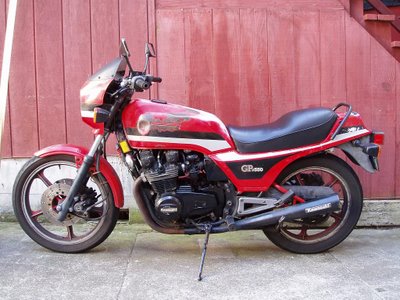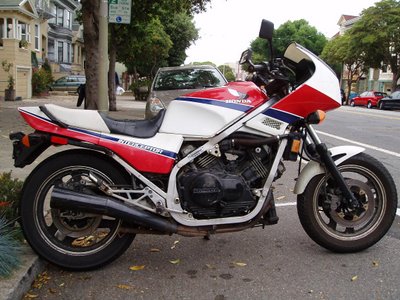Hello and welcome. This guide is designed for you, the new rider. You can read through the guide from start to finish or skip to one of the three sections below. Feel free to ask any questions you have in the comments section below or on the
Craigslist Motorcycle Forum.
The first thing you are going to need to do is to get authorization from your state to ride. There are two ways of doing this;
The best way of doing this is to attend a motorcycle safety course approved by the Motorcycle Safety Foundation (1-877-RIDE-411). A MSF approved course provides you with five hours of classroom instruction and ten hours of practical riding in a controlled, off-street environment. Motorcycles and helmets for use in the course are included in your course fee.
There are several positive reasons to do this. First, attendance in the course grants you a motorcycle endorsement on your driver’s license once you pass the written test at your local DMV or RMV. Second, riders who have attended a safety course are significantly less likely to have an accident. Third, most insurance companies will reduce your insurance payments up to 15% every year for having attended a MSF approved course. This can easily pay off financially if you intend to ride for more than a few years. It is the recommended method of acquiring a motorcycle driver’s license.
The process is this. Sign up for the course. Attend the course. Get the slip from the MSF instructor showing that you passed the course. Go to the DMV or RMV and show them the paper slip. Pass the written DMV test. Walk out with DMV license.
The second alternative is to acquire a permit to ride a motorcycle at your local RMV or DMV. In California, this requires that you pass the written portion of the motorcycle driver’s test. Once you do so, the permit allows you to ride during daylight hours only and restricts you from riding with passengers or on the freeway at any time. It is highly recommended that you pick up a motorcycle rider’s handbook from the DMV or RMV and read it cover to cover before taking your test.
To graduate from a permit to a license, you must pass a
skills test at the DMV, during which you will need to demonstrate proper safety and handling skills while riding on an enclosed course. It is recommended that you make an online appointment before you go in order to cut down on the time in line at the DMV. Again, taking the MSF course allows you to skip this second step while at the same time reducing your insurance costs, giving you hours of practical motorcycle riding experience while riding on someone else’s bike and coaches you on how to be a safer rider.
- Step One: Protect Yer Noggin
While laws vary from state to state with regards to the mandatory use of helmets, it is recommended that all riders use helmets as the minimum level of protection when riding a motorcycle. Remember, someone loves that silly head of yours, even if it isn’t you.
There is much debate, both within the motorcycle enthusiast community and among motorcycle manufacturers domestically and internationally, with regard to what is the ‘safest’ helmet. To read more on the details of the debate, check the article “
Motorcycle Helmet Performance: Blowing the Lid Off” by
Motorcyclist Magazine.
Ultimately, it is my opinion that a Department of Transportation (DOT) approved helmet provides an appropriate level of protection for all riders. Since this is a requirement for all helmets sold in the US, you will be well served in terms of safety with nearly any selection provided in a shop.
Ultimately the best helmet is one that fits well. Visit a local motorcycle shop and try several helmets on. At this point, don’t bother looking at the price tags. The ideal helmet fits snugly on your head and has very limited motion as you swing your head right from left and back and forth. Wear each helmet for a few minutes to get a feel for it. Does it press uncomfortably on your forehead or behind your ears? If you don’t find anything comfortable, go to another shop. It is not unusual to have to visit two or three shops until you find the right helmet for you. Now pick the top two or three helmets you like and compare prices and features. A more expensive helmet is not safer, since all helmets must meet DOT safety guidelines. Generally, the higher cost reflects reduced weight and more features (better venting systems, anti-fogging visors, etc.). The price of helmets can vary enormously, from $79.95 to over $1000.00. It is very realistic to find a good helmet that fits you comfortably in a price range from $100 to $300. Again, don’t let the price of a helmet make you feel that your safety is being compromised. Purchase the helmet you prefer.
Note: It is highly recommend that you NOT purchase a used helmet. The material that protects you in a crash is the lining inside the helmet. During an impact, that material deforms to take up the force of the impact, thus preventing or reducing head injury. To determine whether a helmet has been in such an impact, an x-ray is required to view if the lining has collapsed -- a visual inspection will not suffice. If the lining is damaged from a crash, the safety of the helmet is compromised. Because of this, even if a used helmet does fit comfortably, which is rare, there is no guarantee it will protect your head in an accident. Also note that the interior lining degrades when exposed to UV light, solvents, and even sweat. It is recommended that you replace it a minimum of every five years.
- One More Thing, Good Looking
There is also some debate about full face or 3/4 face (a.k.a. open face) helmets. Nearly
35% of helmet impacts involve the rider falling on the chin area. Even a fall from a standing position to your chin can involve serious injuries. At high speeds on road surfaces, it can be gruesome. If you are good looking, protect that chin, and if you aren’t, do us a favor and hide it (for safety’s sake).
- Step Two: Protect Your Other Bits
Even more so than helmets, there is a debate about what is appropriate external gear. Rather than get into details, it is this rider’s recommendation that you purchase motorcycle gloves, a jacket (preferably with a liner that can be removed in summer) and pants (or a full one piece suit), and heavy-duty boots. All should fit snug and not flap in the wind. Unlike helmets, used gear in good condition can afford good protection. Different materials reflect different philosophies with regards to safety, comfort, and price. Do some research and purchase those items you feel will best protect you. Remember that purchasing gear is an intrinsic, not optional, cost of riding a motorcycle. You either dress for the ride, or you dress for the crash.
It is nearly every new rider’s instinct to get something new and shiny and expensive. You are not unique in this. And since I’ve been a killjoy so far, I find no reason to change my tune.
The first thing I’d like to stress is that your first bike is to learn on, not to ride forever. You want a bike that you will grow out of, not a bike that you will need to grow into.
You should purchase your first bike with the understanding that you will be trading up to something newer, shinier, and more expensive in the next year or so. For your first bike, you want something that is appropriate to your level of experience and something that won’t either take you to the cleaners or make you cry when you drop it.
First, size. Bikes are generally divided by size and type (Sport, Standard, Cruisers, etc.). Size refers to engine size and is measured in cc’s (cubic centimeters of engine displacement).
For a new rider, the size of the engine should reflect your experience, and most rider’s recommend a bike in the range of 250cc to 600cc depending on your size. A smaller, lighter bike is more maneuverable and easier to handle than a larger bike.
Maybe this is just the inner cheapskate in me, but the second recommendation is that you buy a cheaper used bike in good working order. The reason for this is because as a new rider you are very likely to drop the bike. Dropping a bike with lots of chrome or plastic can easily cost hundreds of dollars to replace. You might be better served with an older beginner bike that you will feel less upset about when you forget to put down the kickstand and it falls over. You can find many such motorcycles advertised in the classifieds sections on Craigslist or other publications. In a year, or when you feel comfortable, you can then sell that motorcycle right back into the used market to the next beginner with little or no financial loss and put that money into your new, shiny, expensive bike.
As a last point on motorcycle selection, it is worth noting that insurance coverage for motorcycles varies on many factors (having passed an MSF course, age of the rider, etc.) but is heavily influenced by the type of bike being ridden, with sport bikes being the most expensive to insure. It may be worth calling your insurance company and getting a quote on the bike you are interested in. It is not unusual to spend $800 to purchase a used sport bike only to turn around and spend nearly that much to insure it per year.
Yes, yes, all of that information above was very enlightening, but you actually want a list of bikes. Well, here you go, but please remember list this is not definitive. There have been thousands of different bikes produced over the last thirty or forty years out there that would fit the above guidelines. These are just ten bikes some folks on the Craigslist motorcycle forum came up with over the course of one day. If you find a bike you like that isn’t on this list but still fulfills most of the guidelines set above, go for it.
- Honda Nighthawk 250, 550 or 600
- Honda Rebel 250
- Honda Shadow VLX 600
- Honda VTR 250
- Kawasaki Ninja 250
- Kawasaki Ninja EX500
- Suzuki GS500
- Suzuki GZ250
- Yamaha Virago 250
- Yamaha XT225
Again, don't let the engine size fool you, anyone of these picks will do at least 90MPH holding someone over 200lbs, and really how often are you going to go over 90MPH on a highway?
That is it. If you have any questions regarding this or have any other motorcycle related questions, please feel free to post them here or on the
Craigslist Motorcycle Forums, where we all are eager to answer your questions. Ride Safe!







 I recently sold two of my bikes, a Kawasaki GPZ550 from Sony’s old roommate Eric (top) and a 85 Honda VF700 Interceptor purchased from Dave’s down stairs neighbor.
I recently sold two of my bikes, a Kawasaki GPZ550 from Sony’s old roommate Eric (top) and a 85 Honda VF700 Interceptor purchased from Dave’s down stairs neighbor.